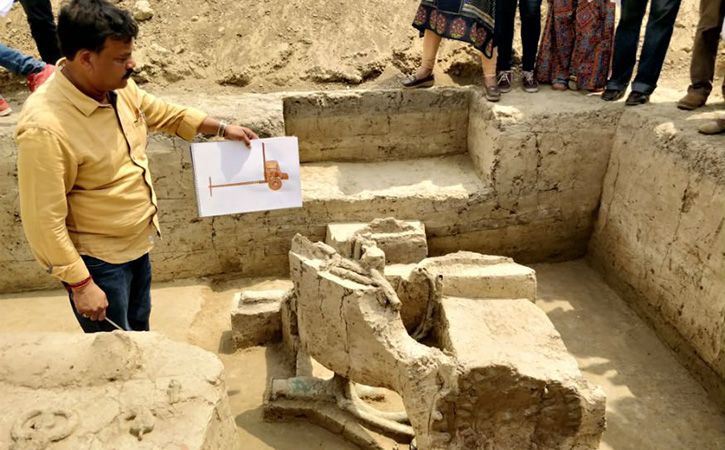
Recently at Sinauli village of Baghpat district in Uttar Pradesh Archaeological Survey of India (ASI) has stumbled upon the remains of a chariot that dates back to “Bronze Age” (2000-1800 BC). In the excavation eight burial sites and several artifacts, including three coffins, antenna swords, daggers, combs, and ornaments, among others have also been unearthed. The three chariots found in burial pits indicate the possibility of “royal burials” while other findings confirm the population of a warrior class.
The attempt has been to prove that Indians knew the chariots in Bronz age. These chariot remains are of solid wheels. No existence of the horses is recorded in this region. The funeral in coffins is significant because it has not shown any affinity with Harappan civilization, though the beads, pottery, and other cultural material – were similar to those of the Harappan civilization as per the ASI team.
It has been conceived that these are elaborate royal burials and that the population might belong to the warrior class. Of course, these are assumptions. Some over-enthusiastic people have started to link this finding with the Vedic Aryans, and their being indigenous, the way Dr. Vasant Shinde recently tried to link Genetic information coming from some five-thousand-year-old three skeletons, excavated at Rakhigarhi, with the Vedic culture. First of all genetics do not tell anything on language and culture, still, an unscientific statement was made in euphoria in an attempt to stake a claim of Indus-Ghaggar culture.
As far Sanauli findings, the so-called chariot is very heavy with solid wheels, difficult for horses to even pull it. Vedic literature speaks of lightweight and spoked wheel chariots. The burial in coffins is not mentioned anywhere in Vedic literature. ASI has admitted that another cultural material is similar to the Harappan. This does mean that the coffin-burial with the cart-like vehicle was independent innovation and had nothing to do with other civilizations.
Other unearthed artifacts like antenna swords, daggers in big quantities possibly could indicate that the people who were buried belonged to the warrior class. It does not mean this class was of permanent nature, birth-based as Vedic literature classifies population in different but permanent classes (varnas). Ancient Indian tribes of Uttar Pradesh had their own independent practices, some tribes being warring and some not. The funeral practices also would be slightly or more different as has been noted in Harappan varied burial practices.
The chariot (if at all it has to be called chariot) remain does not find any similarity with the description of horse-driven chariots of the Vedic people. On coffins copper plated anthropomorphic figures – having horns and peepal-leafed crowns have been recorded. The peepal tree has been religiously revered by Indus-Ghaggar people and so the Hindus of the modern era. It only shows cultural continuity without any outside influence, not even Vedic.
Indians from ancient times were in contact with central Asia and the Middle East from 7000 years ago. The exchanges of some cultural and linguistic elements were obvious. From these two-thousand BC findings only indicate that Harappans did not move towards the east, but these parts also were flourishing independently though they had close cultural relations and trade with Indus-Ghaggar regions, though every region had their unique ways of the expressions through the material cultural artifacts were similar.
It will be a bold claim to relate these findings with Vedic Aryan civilization which was yet to emerge that too far afar in southern Afghanistan!